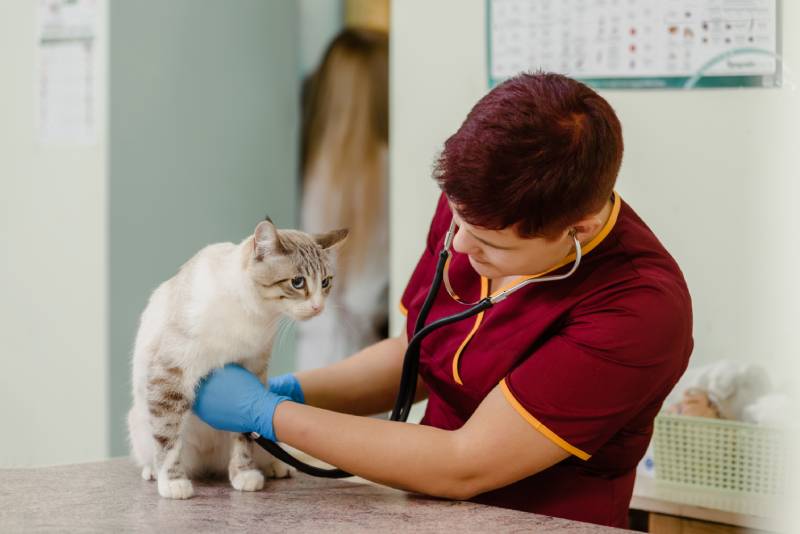
Marigolds are cheery and pretty little flowers that are an eye-catching part of any home garden. They’re also one of the most popular flowers, because they repel pests and attract a wide variety of beneficial insects. If you have cats, though, you might be wondering if these beautiful blooms are harmful to have in your garden? Certain types of marigolds can cause adverse reactions in both cats and dogs.
Keep reading to learn everything you need to know about growing these beautiful perennials while also keeping your cat safe.
 The Two Main Types of Marigolds
The Two Main Types of Marigolds
Before determining if the marigolds growing in your garden are safe for your cats to be around, you should know about the different species of marigolds.
Marigolds are classified into two different types: calendula officinalis and tagetes. Calendula officinalis is often known as the “pot marigold,” while tagetes are more commonly known as “French marigolds.”
Pot marigolds are part of the Calendula genus and are not technically a marigold by definition. French marigolds are part of the Tagetes genus like all other marigold species.
Pot marigolds are considered to be non-toxic to cats and dogs. They go by a lot of different names, such as calendulas, Mary bud, gold bloom, Scotch marigold, or the common marigold.
Tagetes, on the other hand, can be toxic to pets.

How to Tell the Two Types of Marigolds Apart
If you already have marigolds growing in your garden, you might be wondering how you can differentiate between the two species? You may not want to keep them growing in a place your cat can find them if they’re French marigolds, but the pot variety will be just fine to keep around.
True marigolds like the French variety are native to South America, southwestern North America, and the tropical areas of America. Calendulas, like the pot marigold, are native to northern Africa and parts of Europe.
There are also some appearance differences between the two flowers that are good to familiarize yourself with.
The seeds of calendula flowers are bump, brown, and curvy, while marigold seeds are straight, black, and have white tips.
Calendula flowers can grow to be as high as two feet tall in the right growing conditions. Marigolds can grow to be a wide variety of sizes. They can be as small as six inches high to as tall as four feet.
Calendula plants have a lovely and sweet aroma, while a marigold plant has a strong and unpleasant odor.
The shapes of their petals are different, too. Calendula petals are long and straight, while marigolds have a more rectangular-shaped petal with slightly rounded corners.

What Happens If My Cat Eats Marigolds?
While pot marigolds are considered to be non-toxic, that doesn’t mean your cat won’t have some adverse side effects after chowing down. The main symptom is likely to be mild gastrointestinal upset. In most cases, this side effect isn’t caused by the actual flower but is a direct result of eating something that’s not usually in their diet.
Marigolds in the tagetes species can create more serious problems for your kitty. While the toxicity is still considered to be moderate in comparison to other, more poisonous plants, you should still consider taking your cat to the vet to be given a once-over.
Symptoms of marigold poisoning can vary in intensity and body location. As with most things, the more your cat eats, the more likely which can potentially become more serious. If your cat doesn’t eat the plant but instead comes into contact with its sap, they may develop skin irritation.
What Should I Do If My Cat Ate Marigolds?
So, you have evidence that your cat might have come into contact with your marigolds. Now what? What do you do if you don’t know which species of marigold you have growing in your garden?
The good news is that the side effects of eating a marigold (even those in the tagetes species) are often very mild. This is especially true when we compare these to the side effects your cat might experience after eating extremely poisonous plants like hydrangeas or daffodils.
While marigold toxicity is considered rather mild, it can be more serious in some cats. Depending on how much your kitty ate, what their health condition is, their age, and how well their immune system works, your cat could have a more serious reaction than the typically mild one most cats experience.
If you’re ever in doubt about what plant your cat ate or how much, it’s best to speak to an animal poison control center or your vet. A visit to the emergency clinic might be necessary if your kitty is displaying severe side effects that require immediate care and diagnosis.
You never know when your curious little kitty is going to get into something they shouldn’t, so it’s a good idea to have the right resources on hand at all times. The 24/7 ASPCA Poison Control Center’s phone number is (888) 426-4435. Call this number at any time of the day if you suspect your pet has eaten a substance that could be poisonous.
It may be that your vet or the poison control line tells you to wait it out with your cat if their symptoms are mild. They might suggest using a pet-friendly shampoo to wash your cat’s skin if they are experiencing discomfort due to the marigold sap. They may also tell you to keep an eye open for dehydration as symptoms like vomiting and diarrhea can cause this.

Are There Plants I Can Grow That My Cat Can Eat?
There are plenty of plants you can grow in your home garden that are safe around cats. Catnip, zinnias, wild pansies, snapdragons, oat grass, rosemary, and bean sprouts are a few options. Oat grass is a great plant to offer your cat. It looks like grass but doesn’t have any serrated or rough edges or foliage, so your cat will be less likely to vomit after they eat it.
For your peace of mind, it’s best to grow plants and flowers from seed. This way you can know for sure that it hasn’t been treated with any harmful chemicals like herbicides that could cause significant harm to your cat.
 Final Thoughts
Final Thoughts
When you’re a flower lover and cat owner, not all plants are created equal. Not all marigolds are going to be safe to grow around your curious kitty. If you’re on the hunt for a bright and beautiful perennial for your garden, make sure you’re searching for pot marigolds by one of their many nicknames.
Featured Image Credit: erwin nowak, Pixabay


 The Two Main Types of Marigolds
The Two Main Types of Marigolds



